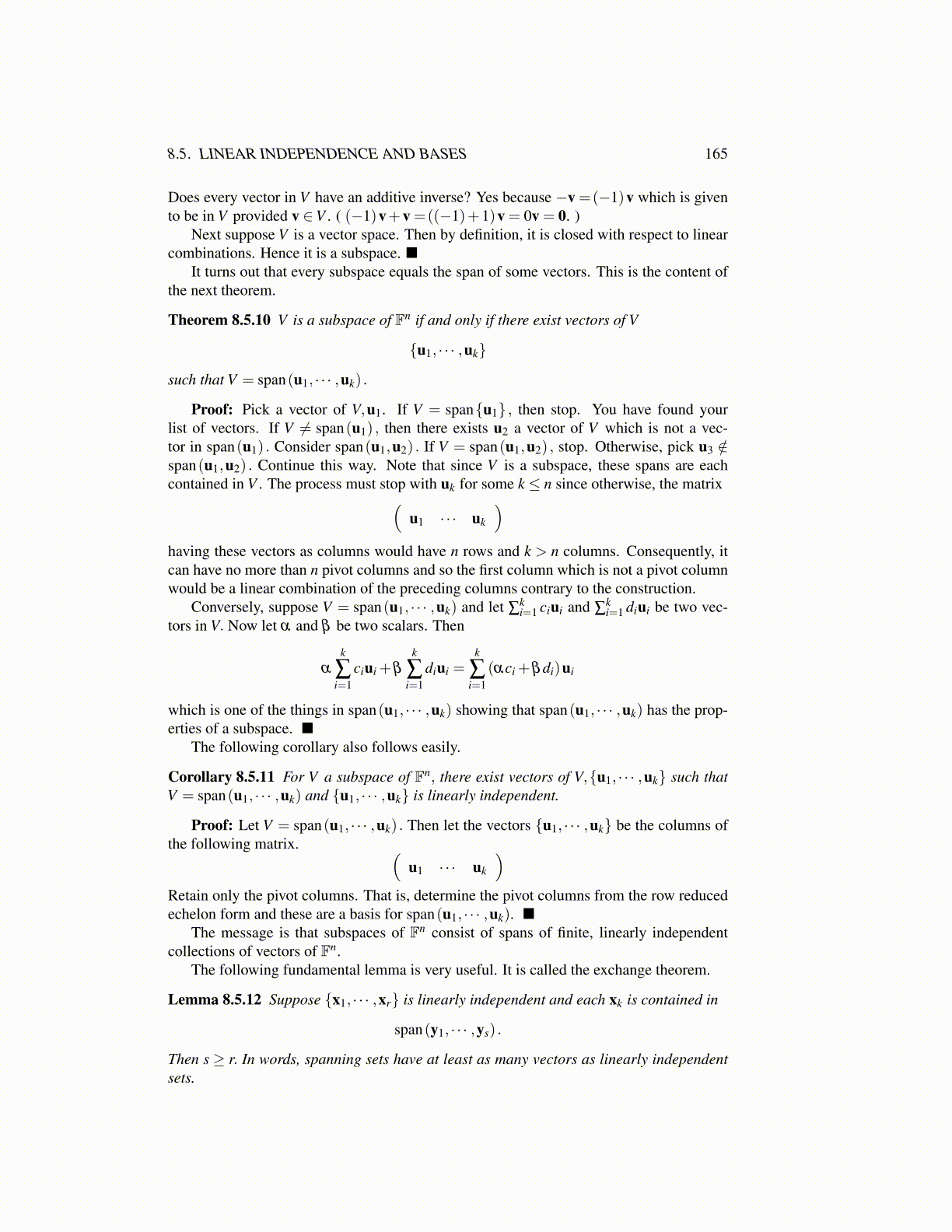
8.5. LINEAR INDEPENDENCE AND BASES 165
Does every vector in V have an additive inverse? Yes because −v =(−1)v which is givento be in V provided v ∈V . ( (−1)v+v =((−1)+1)v = 0v = 0. )
Next suppose V is a vector space. Then by definition, it is closed with respect to linearcombinations. Hence it is a subspace. ■
It turns out that every subspace equals the span of some vectors. This is the content ofthe next theorem.
Theorem 8.5.10 V is a subspace of Fn if and only if there exist vectors of V
{u1, · · · ,uk}
such that V = span(u1, · · · ,uk) .
Proof: Pick a vector of V,u1. If V = span{u1} , then stop. You have found yourlist of vectors. If V ̸= span(u1) , then there exists u2 a vector of V which is not a vec-tor in span(u1) . Consider span(u1,u2) . If V = span(u1,u2) , stop. Otherwise, pick u3 /∈span(u1,u2) . Continue this way. Note that since V is a subspace, these spans are eachcontained in V . The process must stop with uk for some k ≤ n since otherwise, the matrix(
u1 · · · uk
)having these vectors as columns would have n rows and k > n columns. Consequently, itcan have no more than n pivot columns and so the first column which is not a pivot columnwould be a linear combination of the preceding columns contrary to the construction.
Conversely, suppose V = span(u1, · · · ,uk) and let ∑ki=1 ciui and ∑
ki=1 diui be two vec-
tors in V. Now let α and β be two scalars. Then
α
k
∑i=1
ciui +β
k
∑i=1
diui =k
∑i=1
(αci +βdi)ui
which is one of the things in span(u1, · · · ,uk) showing that span(u1, · · · ,uk) has the prop-erties of a subspace. ■
The following corollary also follows easily.
Corollary 8.5.11 For V a subspace of Fn, there exist vectors of V,{u1, · · · ,uk} such thatV = span(u1, · · · ,uk) and {u1, · · · ,uk} is linearly independent.
Proof: Let V = span(u1, · · · ,uk) . Then let the vectors {u1, · · · ,uk} be the columns ofthe following matrix. (
u1 · · · uk
)Retain only the pivot columns. That is, determine the pivot columns from the row reducedechelon form and these are a basis for span(u1, · · · ,uk). ■
The message is that subspaces of Fn consist of spans of finite, linearly independentcollections of vectors of Fn.
The following fundamental lemma is very useful. It is called the exchange theorem.
Lemma 8.5.12 Suppose {x1, · · · ,xr} is linearly independent and each xk is contained in
span(y1, · · · ,ys) .
Then s ≥ r. In words, spanning sets have at least as many vectors as linearly independentsets.